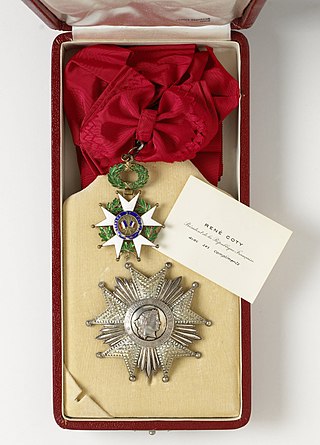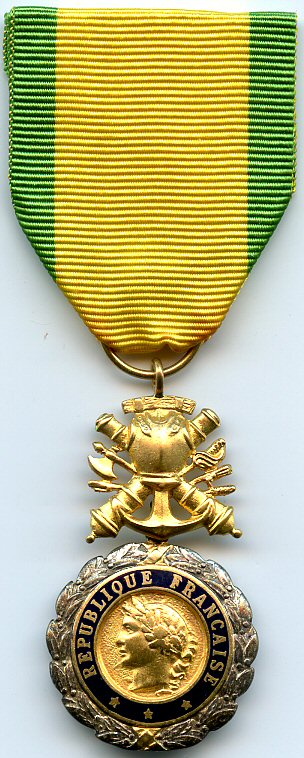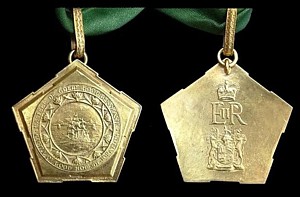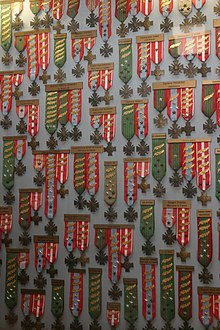
The National Order of the Legion of Honour, formerly the Royal Order of the Legion of Honour, is the highest French order of merit, both military and civil. Established in 1802 by Napoleon Bonaparte, it has been retained by all later French governments and regimes.

A medal or medallion is a small portable artistic object, a thin disc, normally of metal, carrying a design, usually on both sides. They typically have a commemorative purpose of some kind, and many are presented as awards. They may be intended to be worn, suspended from clothing or jewellery in some way, although this has not always been the case. They may be struck like a coin by dies or die-cast in a mould.

The Médaille militaire is a military decoration of the French Republic for other ranks for meritorious service and acts of bravery in action against an enemy force. It is the third highest award of the French Republic, after the Legion of Honour, a civil and military order, and the Order of Liberation, a Second World War-only order. The Médaille militaire is therefore the most senior entirely military active French decoration.
To be mentioned in dispatches describes a member of the armed forces whose name appears in an official report written by a superior officer and sent to the high command, in which their gallant or meritorious action in the face of the enemy is described.

The Order of Leopold is one of the three current Belgian national honorary orders of knighthood. It is the oldest and highest order of Belgium and is named in honour of its founder, King Leopold I. It consists of a military, a maritime and a civil division. The maritime division is only awarded to personnel of the merchant navy, and the military division to military personnel. The decoration was established on 11 July 1832 and is awarded by Royal decree.

An order is a visible honour awarded by a sovereign state, monarch, dynastic house or organisation to a person, typically in recognition of individual merit, that often comes with distinctive insignia such as collars, medals, badges, and sashes worn by recipients.

The Royal Order of the Sword is a Swedish order of chivalry and military decoration created by King Frederick I of Sweden on 23 February 1748, together with the Order of the Seraphim and the Order of the Polar Star. The motto of the order is in Latin: Pro Patria.

The Nkwe ya Boronse - Bronze Leopard, post-nominal letters NB, is a military decoration for bravery which was instituted in 2003. It is South Africa's third highest military decoration for bravery.
The orders, decorations, and medals of Canada comprise a complex system by which Canadians are honoured by the country's sovereign for actions or deeds that benefit their community or the country at large. Modelled on its British predecessor, the structure originated in the 1930s, but began to come to full fruition at the time of Canada's centennial in 1967, with the establishment of the Order of Canada, and has since grown in both size and scope to include dynastic and national orders, state, civil, and military decorations; and various campaign medals. The monarch in right of each Canadian province also issues distinct orders and medals to honour residents for work performed in just their province. The provincial honours, as with some of their national counterparts, grant the use of post-nominal letters and or supporters and other devices to be used on personal coats of arms.

The Castle of Good Hope Decoration was a military decoration for bravery which was instituted by the Union of South Africa on 6 April 1952, but never awarded. The decoration was intended for award to members of the South African Defence Force for a signal act of valour or most conspicuous bravery or some daring or pre-eminent act of self-sacrifice or extreme devotion to duty in the presence of the enemy.
Authorized foreign decorations of the United States military are those military decorations which have been approved for wear by members of the United States armed forces but whose awarding authority is the government of a country other than the United States.

This is a list of Norwegian orders and medals, in order of precedence. This list contains all medals approved for wearing on a Norwegian military uniform in ranked order.

The Grand Cross of Valour was Rhodesia's highest military decoration, awarded for conspicuous valour by members of the Security Forces in combat.

Brita Christina Hagberg, née Nilsdotter, alias Petter Hagberg, was a woman who served as a soldier in the Swedish army during the Russo-Swedish War (1788–1790). She is one of two confirmed women to have been decorated for bravery in battle in Sweden before women were allowed into the military in the 20th century.
During World War II the Independent State of Croatia awarded a number of orders, decorations and medals.
The Cross of Valour is the second highest military decoration of the Greek state, awarded for acts of bravery or distinguished leadership on the field of battle. It has been instituted three times, first on 13 May 1913 during the Balkan Wars but not issued until 1921 during the Greco-Turkish War of 1919–1922, then on 11 November 1940 shortly after the outbreak of the Greco-Italian War and finally in 1974.
The Armed Forces of India are eligible for many military decorations awarded for extraordinary bravery and distinguished service during times of war and peace. Service and campaign medals have been awarded throughout India's history as an independent state.

The Valour Cross is the highest military decoration of Denmark. Established on 14 November 2011, and first awarded on 18 November 2011, it is awarded for outstanding acts of courage in combat.
Vasa Medal Is a Swedish medal, awarded for general civil virtues.
















